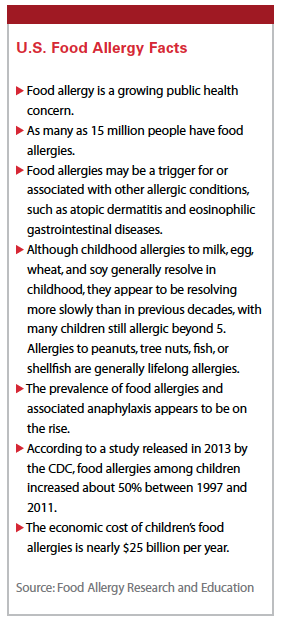Modifying the Immune System for Those with Food Allergies
DBV Technologies’ CEO and Co-founder Pierre-Henri Benhamou talks about his company’s development of a patch for peanut and other food allergies.
 The prevalence of food allergies appears to be on the rise. While there is no cure for food allergies, traditional treatment approaches involve desensitization, which typically involves ingestion of the allergen in some form. But for those with severe food allergies, especially children, this approach can lead to immune reactions, including anaphylaxis.
The prevalence of food allergies appears to be on the rise. While there is no cure for food allergies, traditional treatment approaches involve desensitization, which typically involves ingestion of the allergen in some form. But for those with severe food allergies, especially children, this approach can lead to immune reactions, including anaphylaxis.
According to a study released in 2013 by the CDC, food allergies among children increased about 50% between 1997 and 2011.
The CDC has reported that food allergies result in more than 300,000 ambulatory-care visits a year among children under the age of 18.
One company, DBV Technologies, is developing a proprietary method of delivering biologically active compounds to the immune system through intact skin using a patch called Viaskin. The patch administers an allergen to the immune system without entering the bloodstream and limits the possibility for severe reactions such as anaphylaxis, which allows for a controlled desensitization for those who suffer from severe allergies.
Application of an allergen onto intact skin by Viaskin results in allergen delivery in the superficial layer of the skin without any diffuse passage neither in the dermis, the lymphatic system, or the bloodstream. The allergen is uptaken by specialized immune cells, in the most superficial layer of the skin. After the capture of the allergen, those cells become active and migrate toward the draining lymph nodes where they induce immune modulations.
The company’s technology is being tested to treat patients, including infants and children, suffering from severe food allergies, for whom safety is paramount.
DBV’s patch delivery system can be applied in a broad range of immunotherapies. The company’s lead product is Viaskin Peanut, which initiated in December its Phase III study, called PEPITES in the United States, Canada, Australia, and Europe, as a treatment for peanut allergic children 4 to 11 years of age. Results of a Phase IIb study, called OLFUS-VIPES, showed a favorable safety profile. The product received FDA Breakthrough Therapy Designation in children in April 2015 and an EMA Positive Opinion on Pediatric Investigation Plan.
 The Viaskin patch — a combination of new technology and new methods of treatment — is based on an electrostatic patch. The patch is positioned on intact skin, without prior preparation. The condensation chamber formed between the skin and the center of the patch creates hyperhydration of the skin and an accumulation of water. Once in the epidermis the allergen is captured by a population of highly specialized cells. These cells are able to take the protein and present it to the immune system in order to modify a slowly progressive immune response.
The Viaskin patch — a combination of new technology and new methods of treatment — is based on an electrostatic patch. The patch is positioned on intact skin, without prior preparation. The condensation chamber formed between the skin and the center of the patch creates hyperhydration of the skin and an accumulation of water. Once in the epidermis the allergen is captured by a population of highly specialized cells. These cells are able to take the protein and present it to the immune system in order to modify a slowly progressive immune response.
Phase I results show Viaskin has a good safety profile in both peanut and milk allergies. In peanut allergy studies, Phase IIb results showed that after one year, 53% of patients were able to multiply by 10 the amount of peanuts they were able to tolerate. After two years, 80% of the pediatric patients were able to multiply by 10 the amount of peanuts they were able to take.
“This is very important because patients who are allergic to peanuts may have a limited social life," says Pierre-Henri Benhamou, co-founder and CEO of DBV Technologies. “But after the treatment, they are able to live their lives with less fear."
The company also is developing Viaskin products for milk and egg allergies. The company’s second product is Viaskin Milk, and the Phase II trials are ongoing. DBV’s third food allergy treatment in development is Viaskin Egg, which is in preclinical development. Also in preclinical research are therapies for allergic diseases and vaccines, such as a treatment for whooping cough.
“Our intention is to have a new product to launch in the U.S. market every two years," Mr. Benhamou says.
DBV’s technology has applicability for vaccines, inflammatory, and autoimmune conditions. The company has completed preclinical studies of Viaskin in vaccination against respiratory syncytial virus (RSV). Pertussis boost is another current vaccine target. In autoimmune conditions, the company’s current targets include asthma prevention and hemophilia A. In inflammatory conditions, the company’s current targets include irritable bowel syndrome, Crohn’s disease and Eosinophilic Esophagitis (EoE), a condition that causes swelling of the esophagus triggering severe symptoms such as vomiting, abdominal pain, and regurgitation.
In November, the company began enrollment for SMILEE, its Phase IIa study of milk allergy induced pediatric EoE. (PV)










